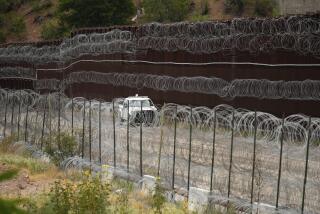Op-Ed: Biden’s shift on the border wall is a deadly mistake

President Biden’s plan to restart building of the border wall, evidenced by the recent seizure of a family’s property for construction, breaks his promise to voters and threatens to derail immigration reform by surrendering to nativists’ framing of the debate: conflating immigration with criminality and immigration enforcement with public safety.
The wall is a potent symbol, shaping the public imagination and stories we tell about the border. Former President Trump used it to stir up anti-immigrant sentiments; Democrats briefly used it to resist him. But now, many Democrats have reverted to their decades-long support for the wall.
When I was growing up in San Diego, regularly crossing the border into my father’s hometown of Tijuana to spend time with family, the Clinton administration erected a corrugated steel wall between the two cities, launching 1994’s “Operation Gatekeeper” and the modern era of border militarization. I was 6, and it transformed my relationship with my father’s country.
Border fencing, a response to that decade’s rampant demographic anxiety and billed as a national security tool, actually strengthened cartels by increasing their incentives and economic rewards, triggering turf wars and bloodshed in Tijuana. My uncles told of bodies dissolved in acid by a man named Santiago Meza López, who was known as El Pozolero. While I’d previously feared imaginary monsters like El Chupacabra and El Cucuy, my nightmares became haunted by real men.
The forces of U.S. border militarization, U.S. drug demand, U.S. gun smuggling (70% of Mexico’s crime scene weapons are traceable to the U.S.) and the North American Free Trade Agreement, which put millions of Mexican farmworkers out of work, created misery, economic displacement, crime and danger. But I didn’t know that as a kid. I simply started to think of Mexico as an inherently scary place.
Border militarization has created the same fear in millions of Americans. It’s made Mexico and immigrants from south of the border scary — the people who grow the food we eat, care for our elderly and power our local economies by filling essential jobs. At the same time, the wall is used by leaders of both parties to distract from the consequences of treaties and policies that have hurt the American working class. It is both a deadly reality and a signifier that shifts blame to the brown men from beyond the wall.
Since the fencing went up, humane immigration reform has repeatedly stalled.
With Biden failing to repudiate the deep-seated fears and anxieties embodied in the wall, pushers of a white nationalist agenda like Stephen Miller, Trump’s former senior advisor, are busy peddling the vision that demographic change will destroy the U.S.
Biden’s obliviousness or indifference will backfire in the 2022 midterms unless he forges a new and true vision of what immigrants offer: hope of survival, of growth. They offset population stagnation and can provide ideas for designing a smarter foreign policy that doesn’t displace millions of people. As Harsha Walia wrote in her powerful new book “Border and Rule,” it is a grave error to “depict migrants and refugees as the cause of an imagined crisis at the border, when, in fact, mass migration is the outcome of the actual crises of capitalism, conquest, and climate change.”
The wall may seem a minor concern compared with the thousands of migrant children crowded into Border Patrol’s upgraded cages or the continuing family separations just south of the border. But for all the children in U.S. custody, there are countless others who didn’t make it because the wall compelled them to cross through the desert. Many will never be found, their dehydrated bodies torn apart by coyotes, and their skeletons scattered across the land.
It is impossible to grasp the violence of border militarization unless you walk the border routes yourself. The expressed intent of the Clinton administration’s “prevention through deterrence” strategy was for people to be “forced over more hostile terrain.” Every time I’ve walked those routes, I’ve encountered new human skulls, alongside Bibles, love letters and dusty children’s dolls. More than 7,805 bodies have been found there since 1998. It resembles a war zone because it is a war zone, designed to kill enough people for them to stop coming.
While conservative pundits rail against child trafficking, the wall pushes children into the hands of traffickers. It destroys native burial sites and wildlife. It’s easy to breach and costly to repair, and reroutes drugs into ports of entry and tunnels. It slows the cross-border exchange of culture and ideas that is critical for our nation’s health.
In “The Divided Self,” the psychiatrist R.D. Laing attributes madness to internal walls between the self and others. “What was designed in the first instance as a guard or barrier to prevent disruptive impingement on the self, can become the walls of a prison,” he wrote.
The same can be said of the border wall. It is a trap, which now shapes and restricts the public debate on immigration in general.
On Friday, Biden nearly caved to Trump’s abysmally low limit on refugees before backtracking in the face of intense criticism. But his approach isn’t all that surprising; according to some, he has been hesitant to raise the refugee cap because of events at the border.
If Biden keeps building the wall, he should not be shocked if the country continues down a path that accepts the destruction of immigrant lives. The wall blinds us to the true crises and paralyzes us in the fight against them.
Jean Guerrero is the author of “Crux: A Cross-Border Memoir” and “Hatemonger: Stephen Miller, Donald Trump, and the White Nationalist Agenda.” She is a contributing writer to Opinion.
More to Read
A cure for the common opinion
Get thought-provoking perspectives with our weekly newsletter.
You may occasionally receive promotional content from the Los Angeles Times.










